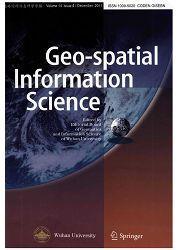Sky-GVINS: a sky-segmentation aided GNSS-Visual-Inertial system for robust navigation in urban canyons
IF 5.5
1区 地球科学
Q1 REMOTE SENSING
引用次数: 0
Abstract
Integrating Global Navigation Satellite Systems (GNSS) in Simultaneous Localization and Mapping (SLAM) systems draws increasing attention to a global and continuous localization solution. Nonetheless, in dense urban environments, GNSS-based SLAM systems will suffer from the Non-Line-Of-Sight (NLOS) measurements, which might lead to a sharp deterioration in localization results. In this paper, we propose to detect the sky area from the up-looking camera to improve GNSS measurement reliability for more accurate position estimation. We present Sky-GVINS: a sky-aware GNSS-Visual-Inertial system based on a recent work called GVINS. Specifically, we adopt a global threshold method to segment the sky regions and non-sky regions in the fish-eye sky-pointing image and then project satellites to the image using the geometric relationship between satellites and the camera. After that, we reject satellites in non-sky regions to eliminate NLOS signals. We investigated various segmentation algorithms for sky detection and found that the Otsu algorithm reported the highest classification rate and computational efficiency, despite the algorithm’s simplicity and ease of implementation. To evaluate the effectiveness of Sky-GVINS, we built a ground robot and conducted extensive real-world experiments on campus. Experimental results show that our method improves localization accuracy in both open areas and dense urban environments compared to the baseline method. Finally, we also conduct a detailed analysis and point out possible further directions for future research. For detailed information, visit our project website at https://github.com/SJTU-ViSYS/Sky-GVINS.Sky-GVINS:用于城市峡谷鲁棒导航的天空分割辅助gnss视觉惯性系统
将全球导航卫星系统(GNSS)集成到同步定位和绘图(SLAM)系统中,全球连续定位解决方案越来越受到关注。然而,在密集的城市环境中,基于gnss的SLAM系统将受到非视距(NLOS)测量的影响,这可能导致定位结果急剧恶化。为了提高GNSS测量的可靠性,提高定位精度,本文提出了从仰视相机中检测天空区域的方法。我们提出Sky-GVINS:一种基于GVINS的天空感知gnss视觉惯性系统。具体而言,我们采用全局阈值方法对鱼眼指向天空图像中的天空区域和非天空区域进行分割,然后利用卫星与相机之间的几何关系将卫星投影到图像上。之后,我们在非天空区域拒绝卫星以消除NLOS信号。我们研究了各种天空检测的分割算法,发现尽管Otsu算法简单且易于实现,但它的分类率和计算效率最高。为了评估Sky-GVINS的有效性,我们建造了一个地面机器人,并在校园内进行了大量的实际实验。实验结果表明,与基线方法相比,该方法在开阔区域和密集城市环境下都提高了定位精度。最后,我们还进行了详细的分析,并指出了未来可能进一步研究的方向。有关详细信息,请访问我们的项目网站https://github.com/SJTU-ViSYS/Sky-GVINS。
本文章由计算机程序翻译,如有差异,请以英文原文为准。
求助全文
约1分钟内获得全文
求助全文
来源期刊

Geo-spatial Information Science
REMOTE SENSING-
CiteScore
10.10
自引率
28.30%
发文量
710
审稿时长
31 weeks
期刊介绍:
Geo-spatial Information Science was founded in 1998 by Wuhan University, and is now published in partnership with Taylor & Francis. The journal publishes high quality research on the application and development of surveying and mapping technology, including photogrammetry, remote sensing, geographical information systems, cartography, engineering surveying, GPS, geodesy, geomatics, geophysics, and other related fields. The journal particularly encourages papers on innovative applications and theories in the fields above, or of an interdisciplinary nature. In addition to serving as a source reference and archive of advancements in these disciplines, Geo-spatial Information Science aims to provide a platform for communication between researchers and professionals concerned with the topics above. The editorial committee of the journal consists of 21 professors and research scientists from different regions and countries, such as America, Germany, Switzerland, Austria, Hong Kong and China.
 求助内容:
求助内容: 应助结果提醒方式:
应助结果提醒方式:


